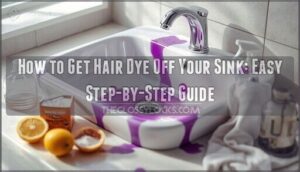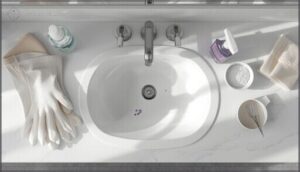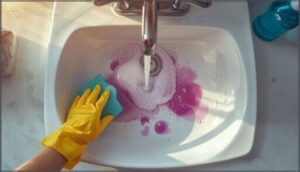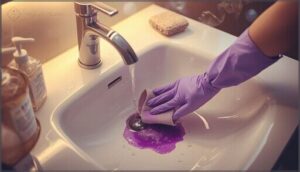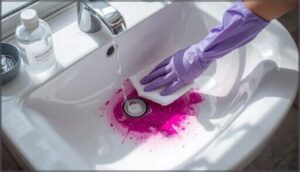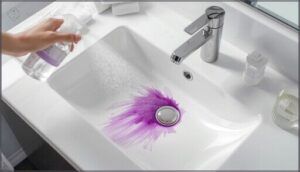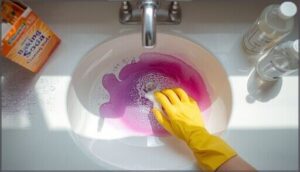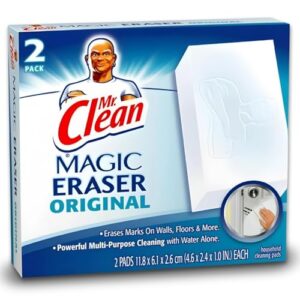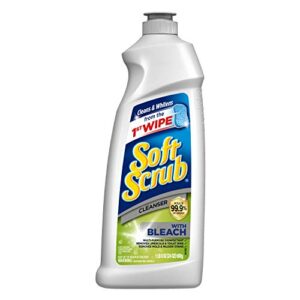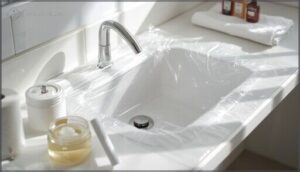This site is supported by our readers. We may earn a commission, at no cost to you, if you purchase through links.
That bright streak of purple across your porcelain sink wasn’t part of your bathroom’s color scheme. Hair dye works fast—which is great for your hair, but not so great when splashes land on your sink and start bonding with the surface within minutes. The longer those stains sit, the deeper they set into porous materials like ceramic and enamel.
You don’t need specialty products or expensive cleaners to tackle this mess. Most effective solutions are already sitting in your kitchen or bathroom cabinet, and with the right technique, you can restore your sink’s original finish without damaging the surface.
Table Of Contents
- Key Takeaways
- What Removes Hair Dye Stains From Sinks?
- How to Prepare Your Sink for Cleaning
- Step-by-Step: Removing Fresh Hair Dye Stains
- Removing Hair Dye With Nail Polish Remover
- Using Rubbing Alcohol to Clean Hair Dye Stains
- Cleaning Hair Dye Stains With Baking Soda and Vinegar
- Best Commercial Cleaners for Hair Dye Stains
- Preventing Hair Dye Stains on Your Sink
- Frequently Asked Questions (FAQs)
- How do you remove hair dye from a sink?
- How to remove hair dye stains?
- Can toothpaste remove hair dye from a sink?
- Can hair dye stain a stainless steel sink?
- How do you remove hair dye stains from a bathroom?
- Can hair dye stains be removed from a tub?
- Can hair dye stains damage my sink permanently?
- How long before hair dye stains become permanent?
- Will hair dye stain grout around the sink?
- Conclusion
Key Takeaways
- Fresh hair dye stains lift easily with dish soap and hot water within 20 to 30 minutes, but waiting longer allows pigment to bond permanently with porous surfaces like ceramic and enamel.
- Rubbing alcohol, baking soda paste, and acetone-based nail polish remover break down stubborn dye stains effectively, though you must test cleaners first since acetone damages acrylic and laminate while bleach can dull older enamel.
- Covering your sink with plastic sheeting and wiping spills immediately prevents stains from setting, saving you from aggressive scrubbing that can scratch or dull your sink’s finish over time.
- Commercial options like Mr Clean Magic Eraser and Soft Scrub with Bleach tackle tough stains when household methods fail, but both require caution—the eraser can dull glossy surfaces and bleach irritates skin while damaging certain materials.
What Removes Hair Dye Stains From Sinks?
You don’t need to run out and buy specialty products to tackle hair dye stains on your sink. Most of what you need is probably sitting in your bathroom cabinet or kitchen pantry right now.
Let’s look at the everyday cleaners and gentle abrasives that can save your sink without damaging the surface.
Common Household Cleaners
You probably already have what you need to tackle hair dye stains on your bathroom sink. Dish soap and hot water work well on fresh spills—surfactants lift dye before it sets. For tougher marks, cleaning with baking soda mixed with vinegar creates a gentle paste that removes stains without abrasive damage.
Rubbing alcohol is another reliable household product; just dab it on with cotton balls. Bleach alternatives like hydrogen peroxide are safer for colored porcelain.
It’s important to remember that hair dye stains can be difficult to remove if left to set. Always test any cleaner first to verify residue removal without harming your finish, and consider eco-friendliness when choosing your approach.
Safe Abrasives for Sinks
When household cleaners don’t cut it, mild abrasive cleaners like Bon Ami or Bar Keeper’s Friend can scrub away stubborn dye without harming your bathroom sink. Material compatibility matters—baking soda works safely on most surfaces, but aggressive scrubbing can damage porcelain or enamel. For stainless steel, fine abrasive grit levels around 240 work best.
Application techniques make a difference: use soft sponges with gentle circular motions instead of steel wool, which scratches deeply. Alternative abrasives like Magic Eraser combine cleaning power with safety. You can keep your sink looking great by cleaning porcelain sinks at least weekly.
Long-term effects of harsh scouring can roughen surfaces and strip protective coatings, so stain removal techniques should always balance effectiveness with safe cleaning practices.
How to Prepare Your Sink for Cleaning
Before you start scrubbing away at those stubborn hair dye stains, you need to set yourself up for success. A little prep work now will make the cleaning process faster, safer, and more effective.
Here’s what you should do to get your sink ready for a proper deep clean.
Clearing The Area
Before tackling any hair dye stains, you need a clean slate. Remove sink clutter like toothbrushes, soap bottles, and cosmetics from your countertop and basin. Clear the basin completely so every inch is accessible for treatment. Protect items by placing them on a clean towel away from splashes—nobody wants ruined toiletries.
Here’s your quick clearing checklist:
- Move all bottles and grooming products to a designated spot
- Rinse the empty basin with warm water
- Relocate electronic devices away from potential water exposure
- Group similar items together for efficient cleanup later
This simple prep makes bathroom cleaning and surface cleaning far more effective.
Safety Precautions and Ventilation
Now that your workspace is ready, let’s talk safety. Hair dye removal products release fumes that can irritate your eyes, nose, and throat—especially in a closed bathroom. Turn on your exhaust fan or crack a window before you start. This simple step keeps vapor concentrations low and prevents headaches or coughing fits.
Wear chemical-resistant gloves to shield your skin from harsh cleaners like bleach, acetone, or rubbing alcohol.
Here’s your safety checklist:
| Safety Step | Why It Matters |
|---|---|
| Open windows or run exhaust fan | Prevents fume buildup and respiratory irritation |
| Wear protective gloves | Blocks chemical contact with skin |
| Never mix bleach with acids or ammonia | Avoids dangerous chlorine gas release |
| Test cleaners on hidden spots first | Protects your sink finish from damage |
These protective barriers make all the difference between safe cleanup and a trip to urgent care.
Step-by-Step: Removing Fresh Hair Dye Stains
The best time to tackle a hair dye stain is right after it happens. Fresh stains haven’t had time to set into your sink’s surface, which makes them much easier to remove.
Let’s start with the simplest methods that work when you catch the problem early.
Using Soap and Hot Water
Fresh hair dye on your sink doesn’t have to be permanent—you can tackle it right now with soap and hot water. This first-line approach works best when you catch the stain early, before it sets. Dish soap contains surfactants that break down dye pigments, while hot water (around 120°F) boosts removal efficiency by up to 40%.
Here’s how to use this method effectively:
- Apply liquid dish soap directly onto the stained area of your sink
- Run hot tap water over the stain for at least 30 seconds
- Scrub with a non-abrasive sponge using circular motions until the dye lifts
Repeat if needed.
Immediate Cleanup Tips
Within 20 to 30 minutes of the dye hitting your sink, the pigment begins to set—so speed matters. Grab a soft cloth and wipe spills immediately, before they dry and bond to the surface. This rapid wiping with a damp microfiber cloth removes most fresh hair dye stains in seconds.
Speed matters with hair dye stains—wipe spills immediately with a damp cloth before pigment sets in 20 to 30 minutes
Use mild agents like dish soap first. Let them sit for a short dwell time—about one to three minutes—then scrub gently. Establish quick habits: rinse your sink with hot water after every use to prevent residue buildup. These simple cleaning tips keep stains from becoming stubborn problems later.
Removing Hair Dye With Nail Polish Remover
Nail polish remover works fast on hair dye stains because it contains acetone, a powerful solvent that breaks down pigment. You’ll need to apply it carefully and know which surfaces can handle it without damage.
Here’s how to use it safely and get the best results.
Application Method
To remove hair dye stains from your sink, saturate a cotton pad with acetone-based remover until it’s damp but not dripping. Gently dab the stains, working from the edges inward to avoid spreading. Let it sit for one to two minutes, then blot with a fresh pad.
Proper ventilation control and skin protection are essential—open a window and wear gloves throughout the process.
Surfaces to Avoid
Not all sinks can handle acetone safely. Skip it on acrylic fixtures, which soften under solvent contact, and laminate countertops, where repeated use cracks adhesive layers. Solid surfaces like Corian risk swelling, while varnished or painted surfaces lose their finish. Even porcelain faces enamel wear from prolonged exposure.
Plastic degradation happens fast—warping and brittleness follow. Protect your surface by testing first or choosing gentler alternatives.
Rinsing and Aftercare
Once the stain lifts, thorough water rinsing protects both your sink and your health. Run tap water over the area for 30–60 seconds to flush away dissolved acetone and dye particles. This simple step ensures fume dissipation and drain protection.
- Wash hands with soap immediately for skin protection
- Open windows or run fans for 10–15 minutes
- Wipe surfaces dry to prevent streaking
- Follow with mild cleaner for complete surface care
Using Rubbing Alcohol to Clean Hair Dye Stains
Rubbing alcohol is another powerhouse for tackling hair dye stains on your sink. It works quickly to break down the dye without harsh scrubbing, making it a go-to option for many surfaces.
Let’s walk through how to apply it properly and what safety steps you’ll want to keep in mind.
Effective Application
Rubbing alcohol is most effective when you saturate the stain completely—think of it like soaking a sponge rather than just misting it. Pour 70% isopropyl alcohol onto a cotton ball or cloth until it’s thoroughly wet, then press it firmly against the hair dye stain. Work in circular motions across the mark, letting the alcohol sit visibly wet for two to three minutes to break down the dye molecules. You’ll see color transferring to your cloth—that’s the magic happening. Always pretest in an inconspicuous area first to avoid dulling your sink’s finish, then wipe away all residue with clean water.
| Step | Action | Why It Matters |
|---|---|---|
| Saturate | Soak cotton ball completely | Ensures adequate contact time with dye |
| Press | Hold firmly on stain 2-3 minutes | Breaks down stubborn color molecules |
| Rub | Use gentle circular motions | Lifts dye without scratching surface |
| Check | Look for color transfer | Shows you’re removing hair dye stains |
| Rinse | Wipe with clean water | Prevents alcohol film buildup |
Safety Considerations
While rubbing alcohol works wonders on stains, it demands respect as a chemical. Always open windows or run your exhaust fan—fume inhalation from alcohol vapors can trigger headaches and throat irritation in poorly ventilated bathrooms. Wear gloves to prevent skin irritation and dryness, especially if you’re scrubbing multiple spots. Keep the bottle away from candles or gas appliances for fire prevention, since alcohol vapors ignite easily. Test material compatibility on hidden areas first—some plastics and acrylics crack under high-concentration alcohol. Stick with 70% solutions for safe concentrations that clean without excessive fumes.
- Open windows before applying to prevent vapor buildup
- Wear nitrile gloves to protect hands from repeated exposure
- Store alcohol away from heat sources and open flames
- Test on inconspicuous spots to avoid surface damage
- Use 70% isopropyl rather than 91% for safer handling
Cleaning Hair Dye Stains With Baking Soda and Vinegar
Baking soda and vinegar work together to lift hair dye stains without harsh chemicals. This method is gentle on most sink surfaces while still being effective against stubborn color marks.
Here’s how to mix, apply, and safely scrub away those stains.
Creating The Cleaning Paste
To create an effective paste, combine 2 tablespoons of baking soda with 1 tablespoon of water, mixing until you get a thick, spreadable consistency that won’t run off vertical surfaces. Once applied, add a light drizzle of vinegar to trigger fizzing—this reaction helps lift stains. Let the paste sit for 10–15 minutes before you start scrubbing.
For tougher stains, substitute hydrogen peroxide or add a drop of dish soap for extra cleaning power.
Scrubbing Techniques
Once your paste has done its job, grab a soft sponge and work in circular motions—this approach removes up to 18% more pigment than back-and-forth strokes. Apply gentle pressure; too much elbow grease dulls enamel.
For corners and drains, switch to a soft toothbrush for directional scrubbing. Let the cleaner do the work, not brute force.
Preventing Surface Damage
While baking soda works wonders, too much pressure scratches porcelain and enamel surfaces permanently. Think of it like polishing silver—finesse beats force every time.
To protect your sink:
- Test your cleaner on a hidden spot first
- Use plastic scrubbers instead of steel wool
- Rinse immediately after removing hair dye stains
Gentle cleaners preserve protective barriers better than abrasive alternatives, keeping your cleaning bathroom sinks damage-free.
Best Commercial Cleaners for Hair Dye Stains
Sometimes homemade solutions don’t cut it, and that’s when commercial cleaners step in to save the day. These products are specifically designed to tackle tough stains without requiring you to mix ingredients or guess at ratios.
Here are the most effective commercial cleaners that consistently remove hair dye stains from sinks.
Mr Clean Magic Eraser Original
Mr Clean Magic Eraser might seem like just another sponge, but its melamine foam structure works like ultra-fine sandpaper on hair dye stains. You’ll find its cleaning performance impressive—just wet it, squeeze out excess water, and gently rub the stained area.
The material composition creates micro-scrubbers that lift stubborn dye without harsh chemicals. However, test an inconspicuous spot first since surface compatibility matters; it can dull glossy finishes.
Safety concerns are minimal during normal use, though microplastic pollution from melamine sponges remains an environmental consideration worth noting.
Best For: People dealing with tough household stains like scuff marks, crayon, or soap scum who want a chemical-free cleaning option and don’t mind the environmental trade-offs.
- Cleans stubborn marks with just water—no need for extra chemicals or sprays
- Works on a huge variety of surfaces, from bathroom tile to kitchen appliances
- Gets into tiny grooves and textures that regular sponges can’t reach
- Breaks down quickly and doesn’t last as long as you’d expect
- Can scratch or dull shiny surfaces if you’re not careful where you use it
- Releases millions of microplastic fibers into wastewater, which isn’t great for the environment
Soft Scrub Cleanser With Bleach
When standard cleaners don’t cut it, Soft Scrub Cleanser with Bleach brings serious stain-fighting power to your sink. The bleach concentration—usually 1–5% sodium hypochlorite—oxidizes hair dye molecules while surfactants lift oily residues.
Surface compatibility matters: it works great on porcelain and solid surfaces, but avoid prolonged contact with older enamel or metal fixtures.
Safety precautions include gloves and ventilation, since bleach irritates skin and eyes. Environmental impact is modest with proper rinsing, though septic system owners should use it sparingly to protect beneficial bacteria.
Best For: Homeowners dealing with stubborn bathroom stains like hair dye, coffee rings, or soap scum on porcelain and solid-surface sinks who need bleach-powered cleaning without harsh scratching.
- Bleach formula oxidizes tough organic stains (hair dye, juice, tea) that regular cleaners can’t touch, while surfactants lift oily residues for a complete clean.
- Micro-abrasive lotion texture scrubs without scratching most surfaces, making it safe for stainless steel sinks and marble countertops when used as directed.
- Kills 99.9% of household germs and sanitizes surfaces with just 3 minutes of contact time, combining stain removal and disinfection in one step.
- Contains bleach that irritates skin and eyes, requiring gloves and ventilation during use—not ideal for people with sensitivities or those cleaning in poorly ventilated spaces.
- Can damage or discolor rubber, painted surfaces, copper, aluminum, wood, and older enamel if left on too long, so you need to test first and watch the clock.
- Watery consistency sometimes requires shaking the bottle hard before use, and septic system owners need to use it sparingly to avoid killing beneficial bacteria.
How to Use Each Product
With each product, start by testing on a hidden spot—surface compatibility varies across sinks.
For Magic Eraser, wet thoroughly, squeeze three to four times to activate, then swipe stained zones with firm, controlled motions. Soft Scrub needs gloves and ventilation; apply directly, scrub gently, then rinse completely.
Never mix cleaning products—residue removal matters more than speed, and safety precautions prevent damage.
Preventing Hair Dye Stains on Your Sink
The best way to handle hair dye stains is to stop them before they start. A few simple habits and protective measures can save you from scrubbing your sink later.
Let’s look at the most effective ways to keep your sink stain-free during your next dye job.
Protective Barriers and Covers
Preventing hair dye stains starts before you even open the bottle. A smart layer of protection beats scrubbing stains later. Here’s how to shield your bathroom surfaces:
- Cover your sink with disposable plastic sheeting secured with masking tape, extending beyond the rim to catch drips
- Place old towels beneath plastic to absorb leaks near grout lines
- Use dedicated dyeing containers instead of direct sink contact
- Protect countertops and walls with plastic film in compact spaces
Quick Cleanup Habits
Your best defense is acting fast—the longer dye sits, the deeper it sets. Keep cleaning supplies within arm’s reach for immediate wiping after any splatter. A quick wipe-down takes seconds but saves hours of scrubbing later.
| Action | Tools | Frequency |
|---|---|---|
| Blot fresh spills | Paper towels, microfiber cloth | Immediately |
| Quick rinse | Hot water, dish soap | After each dye session |
| Light scrub | Gentle abrasives (baking soda) | As needed |
| Surface check | Multipurpose spray | Daily routine integration |
Make bathroom cleaning tips part of your dyeing routine—store a dedicated sponge near your sink for instant stain prevention. This simple habit protects surface protection without adding extra work to your day.
Stain-Resistant Coatings and Maintenance
Think of stain-resistant coatings as invisible shields that protect your sink from future battles with hair dye. Apply nano-coatings or sealants according to Maintenance Schedules—usually every 12–24 months—to maintain Protective Barriers.
The Coating Market Growth reflects increasing demand for Material Technologies that simplify surface protection.
Regular Performance Evaluation ensures your cleaning routine and cleaning products for hair dye work effectively, preventing stains while maintaining clean bathroom surfaces.
Frequently Asked Questions (FAQs)
How do you remove hair dye from a sink?
You can remove hair dye stains from sinks using dish soap and hot water for fresh marks, or stronger solutions like rubbing alcohol, baking soda paste, or bleach-based cleaners for stubborn stains.
How to remove hair dye stains?
Like a tough opponent, hair dye stains require the right strategy. Timing matters—fresh stains lift easier than set-in ones. Match your stain removal methods to your sink’s material compatibility for safe, effective hair dye stain removal methods.
Can toothpaste remove hair dye from a sink?
Toothpaste works on fresh hair dye stains thanks to its mild abrasiveness.
Apply a small amount to the stain, scrub gently with a soft cloth for two minutes, then rinse thoroughly with warm water.
Can hair dye stain a stainless steel sink?
Hair dye stains stainless steel sinks temporarily rather than permanently. Steel grade matters, as SUS304 resists deep etching.
Dye type impact and finish stain resistance determine removability, but preventative measures and immediate cleanup prevent long-term effects.
How do you remove hair dye stains from a bathroom?
You’ll tackle hair dye stains across bathroom surfaces using the same proven methods: rubbing alcohol dissolves fresh marks, baking soda paste scrubs porcelain, and magic erasers lift stubborn pigment from tubs without harsh professional stain removers.
Can hair dye stains be removed from a tub?
Yes, you can remove hair dye stains from your tub. Tub material and stain severity determine cleaner selection—porcelain tolerates stronger solutions, while acrylic needs gentler methods. Quick action, proper prevention methods, and long-term care prevent permanent damage.
Can hair dye stains damage my sink permanently?
Left untreated, permanent dye can etch sink material like porcelain or acrylic, especially if contact time exceeds an hour.
Harsh cleaning methods may worsen surface damage, making removing hair dye stains progressively harder and discoloration permanent.
How long before hair dye stains become permanent?
Most fresh stains lift within 30 to 60 minutes if cleaned quickly.
Cleaning delay beyond a few hours increases pigment bonding, especially with high dye intensity or porous surfaces, making repeated exposure harder to reverse.
Will hair dye stain grout around the sink?
Think of grout as a sponge—hair dye stains grout around sinks because of grout porosity.
Dye persistence depends on quick action; stain severity increases with contact time, making cleaning grout and stain prevention essential.
Conclusion
Think of hair dye stains like unwelcome guests—they’re easiest to remove when you catch them at the door. The methods you’ve learned for how to get hair dye off your sink work because they act fast and match the stain’s chemistry.
Keep your cleaning supplies within arm’s reach during your next dye session, wipe spills immediately, and you’ll never have to choose between bold hair color and a spotless sink again.
- https://www.curee.org/remove-hair-dye-from-sink/
- https://looacademy.com/how-to-get-hair-dye-off-sink-and-bathtub/
- https://cleancurious.com/how-to-clean-porcelain-bathroom-sink-from-hair-dye/
- https://www.facebook.com/groups/homedesign/posts/2098538654202310/
- https://barkeepersfriend.com/how-to-remove-hair-dye-from-a-sink/

